CRO Medical (Missoula, MT) is excited to announce the Hoist Harness. An ALL-IN-ONE riggers belt, gun belt, and assault climbing harness. Now available for select government buyers. Public release is scheduled for Summer 2023. For inquiries email support@cromedical.com
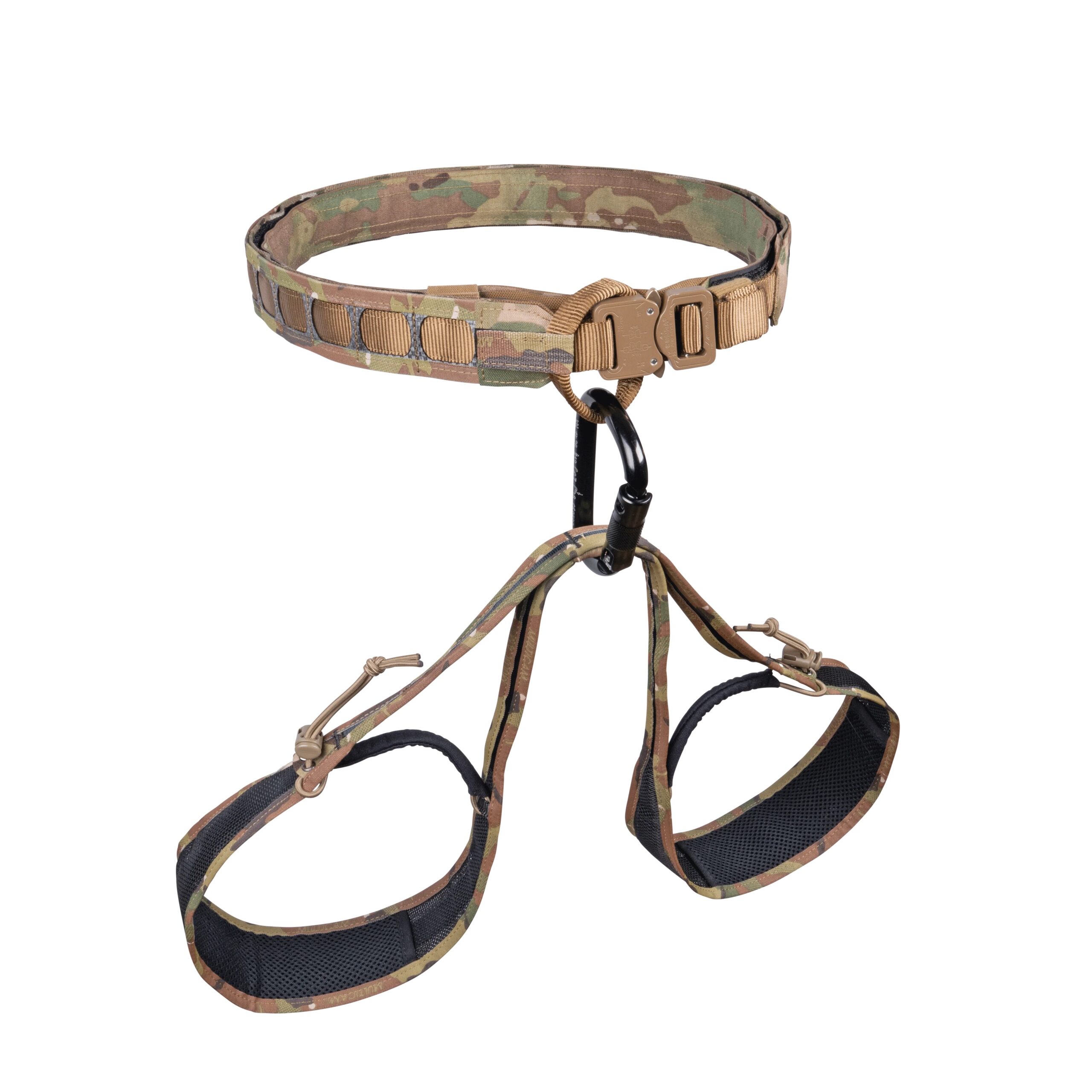
Almost everyone needs a vertical capability at some point in their career. The most common load-bearing feature is a hard-point tether attachment from a gun belt. This is fine for tying into helos or elevated positions but generally not suitable for rappelling, belaying, hoisting, or climbing, something you inevitably find yourself doing on occasion, regardless of the job.
We surveyed the market about a year ago to see what commercial options were available for hard point tethers in gun belts and climbing harnesses for tactical and civilian use. It became clear that there was a significant gap in capability for an all-in-one riggers belt, gun belt, and climbing harness.
We embarked on a year-long process researching and building countless prototypes, testing, and validating the design. This is what we discovered:
For flight missions that focus on hoisting, the Misty Mountain ISH harness or Edelrid tactical harness were common choices when surveying the community. The primary features that were most desirable for flight missions included:
1 Comfortable leg loops must be worn all day and hoisted for extended periods
2 Working loop to secure the carabiner for ease of clipping in
3 Load-rated friction buckle, commonly found in climbing harnesses, due to some flight crews not allowing cobra buckles
4 Lightweight and easy to integrate into existing gun belt setups
The ground assault mission has several different requirements. We had to strike a balance between a harness always worn for climbing or flight operations and an “in extremis” vertical capability when lowering, hauling, or hoisting for HAF, climbing, and VBSS assault missions.
For the ground force, the most desired features were the following:
1 Gun belt suitable for all existing tools and solid shooting platform
2 Rated climbing harness integration
3 Compact leg loops for “in extremis” use
4 Not dropping the gun belt to don the harness
Design
Eventually during the process we had a “light bulb” moment and decided that the inner belt should be the load-bearing component of the system. The inner belt would also replace the riggers belt and be worn all the time. The outer belt would provide a stable shooting platform, and the leg loops would need to detach to prevent dropping the belt when stepping into the harness. Never a good idea to drop your pistol, especially in a hasty hoist situation.
Here’s the full breakdown:
Inner Belt
The Inner Belt replaces the riggers belt for everyday wear with combat pants, a key design feature of this product. The inner belt has a load-rated friction buckle and a belay loop/ working loop fixed, so no matter what, you always have a load-bearing capability whether you are using your gun belt or not. This also makes for an ultra-lightweight climbing harness. Feedback from the pararescue crowd confirmed working on the tower all day without the outer gun belt, but still having the harness available was a nice feature.
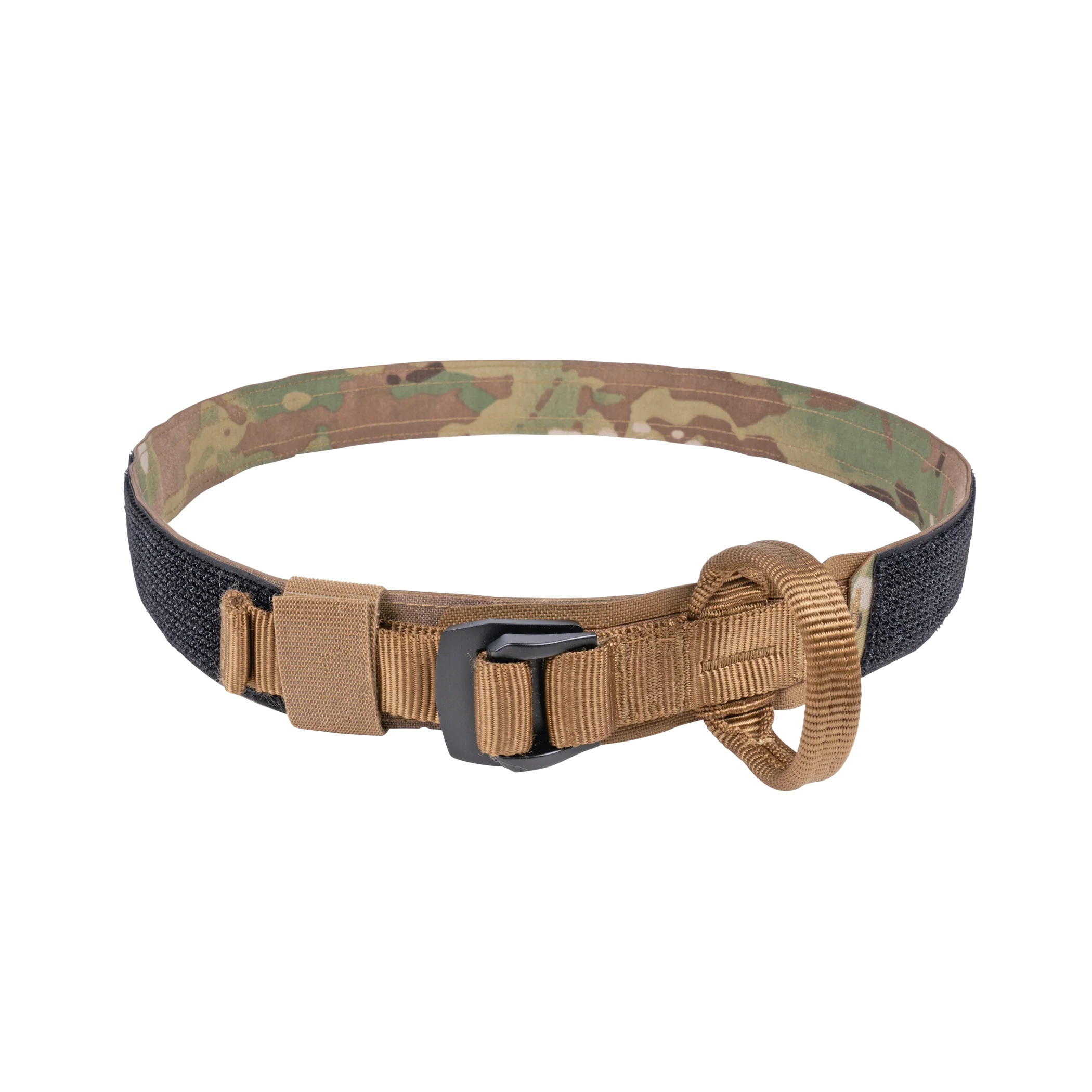
Belay Loop/ Working Loop
The load-bearing aspect of the product required us to certify both EN 12277 and EN 358 safety standards. This is the Type C fall arrest standard, including the belay loop being rated to 15 kN.
We had to lean into our material selection to meet the 15 kN safety rating while still being small and low profile. We settled on Sterling climbing webbing, which is both load rated and has a reliable supply chain.
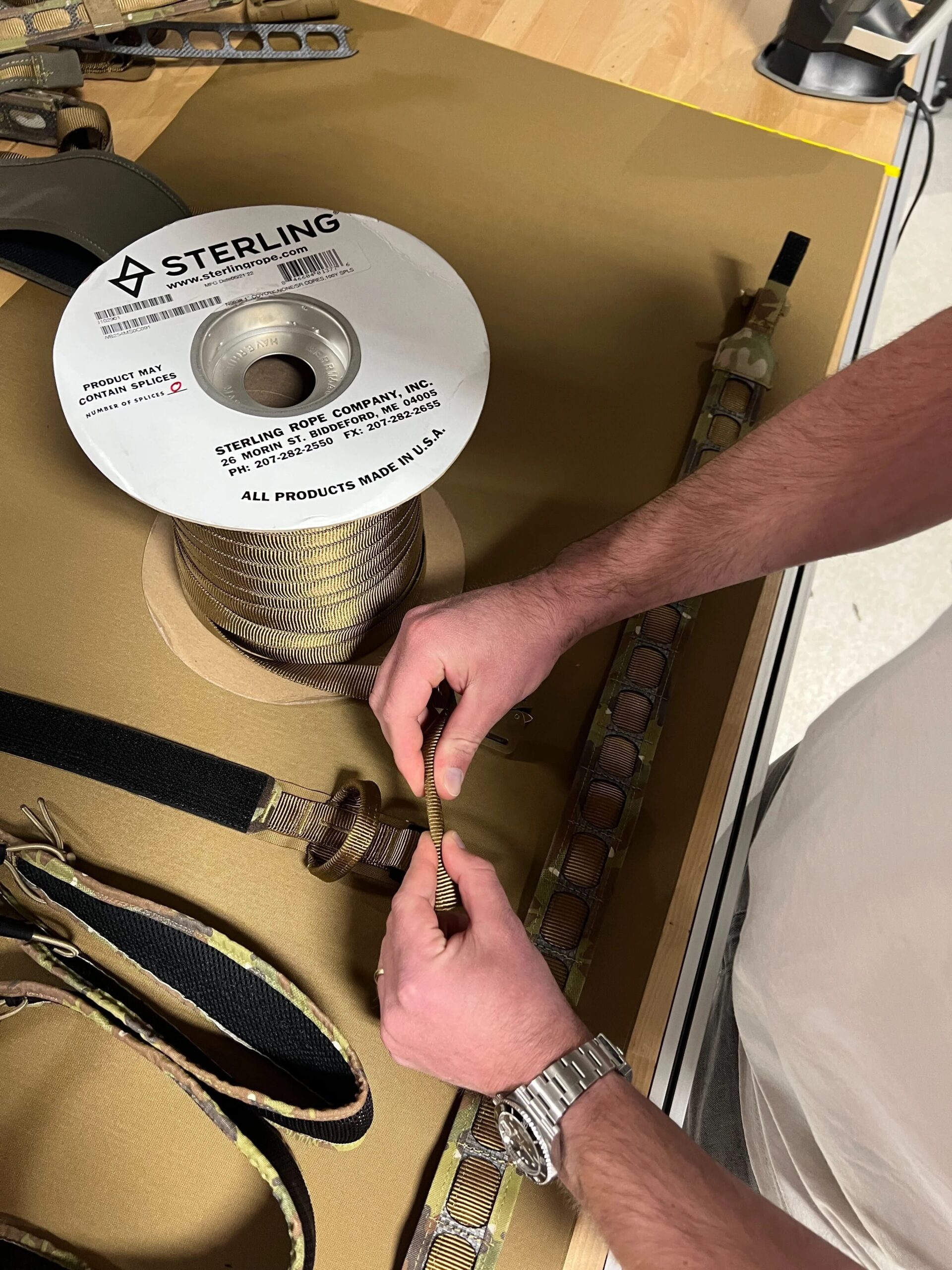
Engineering an anodized aluminum friction buckle
Creating custom hardware for this project proved to be more complicated than we initially anticipated. Luckily, we have engineers on staff at CRO. We ended up with a custom friction buckle that works well with our webbing selection and has excellent retention while still allowing the user to tighten and loosen easily, which is required to route the inner belt through your belt loops.
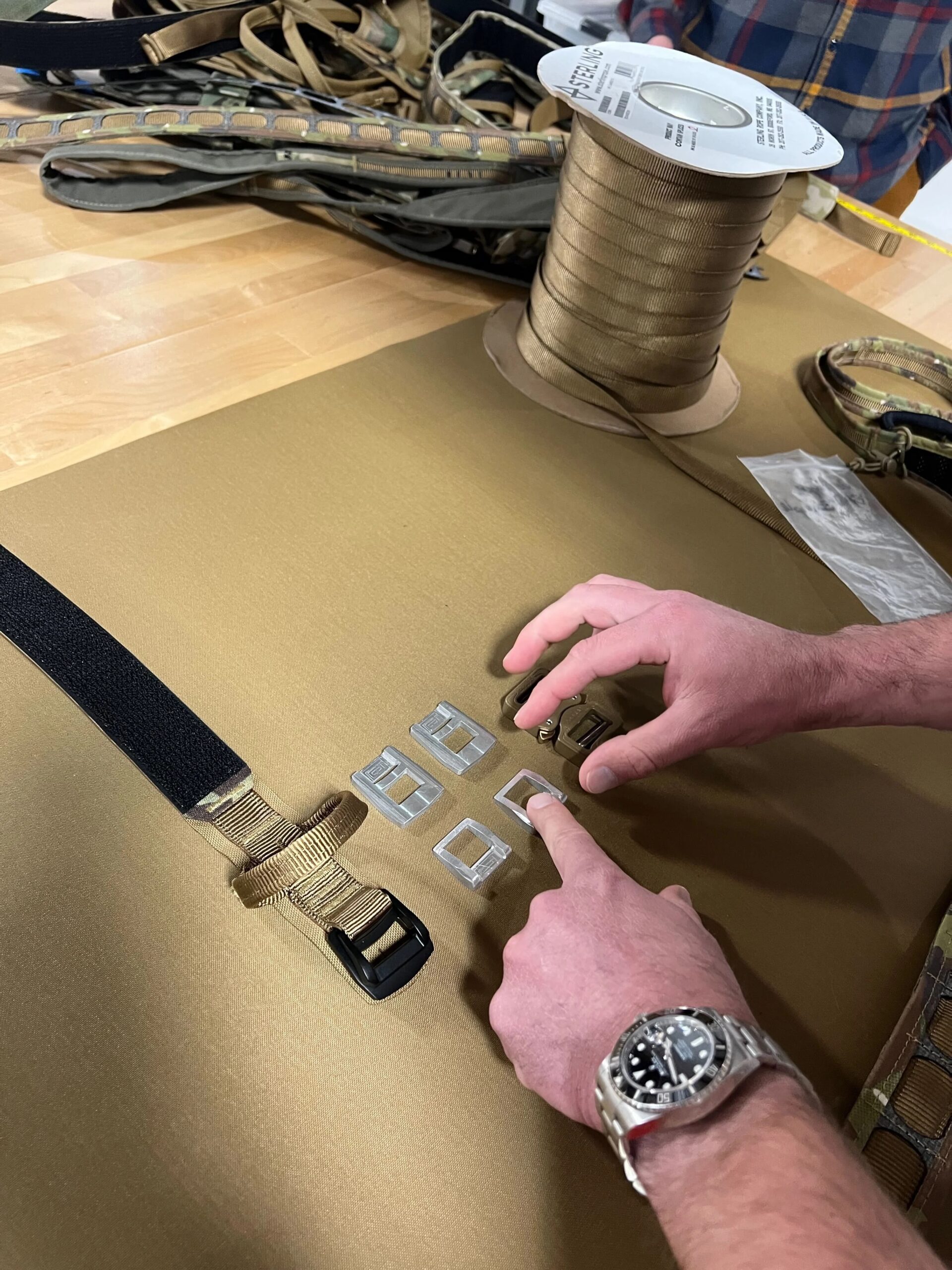
Outer Belt
The Outer Belt needed to be familiar and functional for mounting a pistol, mags, dump pouch, tools, etc., but also needed to integrate with the inner belt. It’s bad practice to load metal on top of metal, so we offset the inner belt friction buckle to the side in the appendix area and centered the working loop/ belay loop. When loading the outer belt, the Cobra buckle routes through the belay loop, and both are centered. A perfect setup and the belay loop has a retention strap when not used. This makes a very clean, stable shooting platform with a ton of working space to mount tools.
Designing the Leg Loops
Retention was a key design metric during the process. The problem with most leg loops is they don’t stay in place when you put them on. They tend to sag and fall down the back of your legs. We found the ideal balance of retention, functionality, and comfort through trial and error.
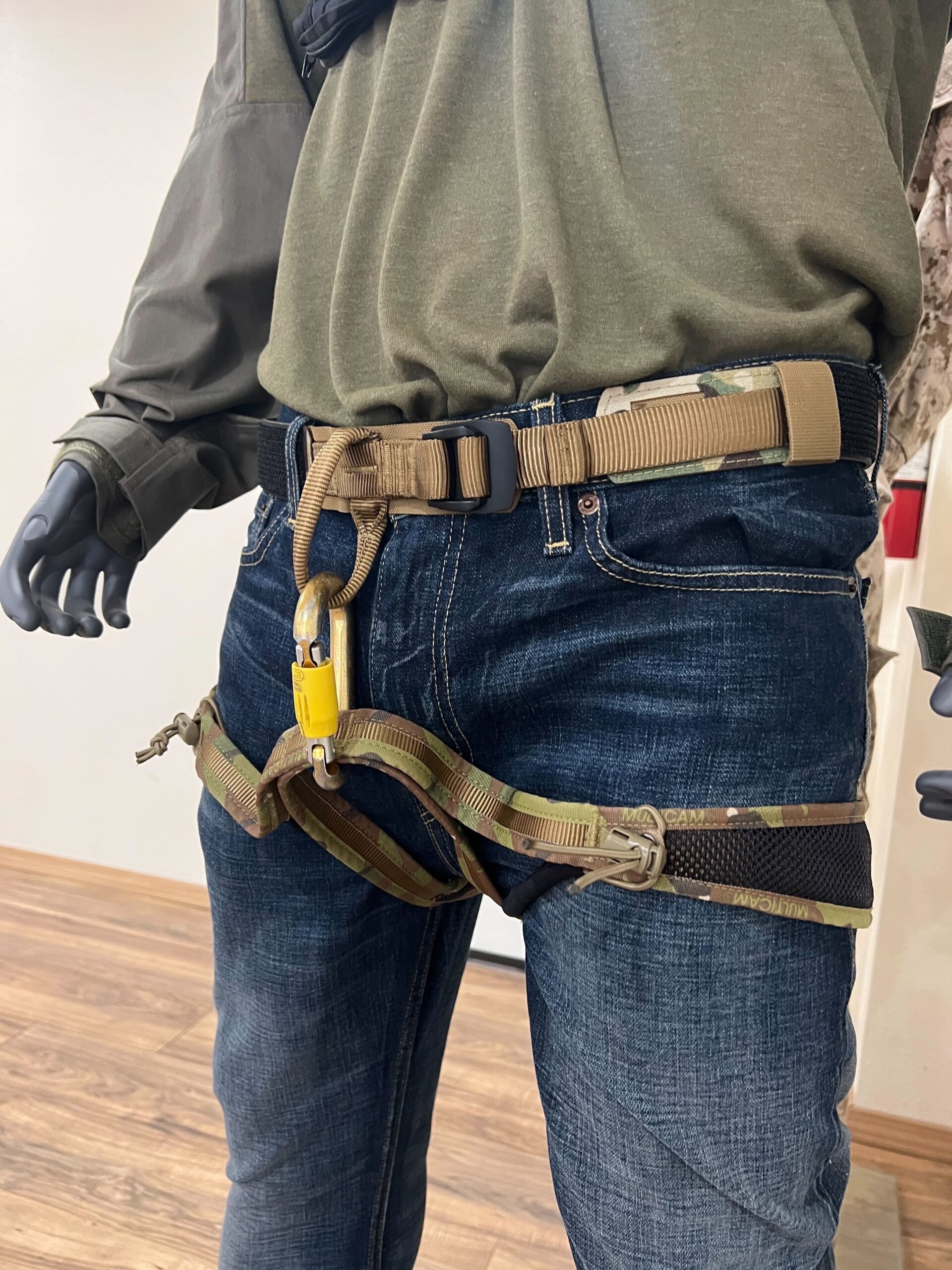
These turned out really well, and they pack down nicely. They’re not too bulky like the ISH harness leg loops (although not quite as streamlined as the Arc’teryx Leaf leg loops), but they provide a REAL hoisting capability and are actually comfortable to use. Removing the tightening buckle hardware also allowed us to slim it down.
The result of this project is a riggers belt, gun belt, and assault climbing harness, all-in-one. So far, the feedback has been tremendous, and we look forward to getting this out to anyone needing a gun belt and a vertical capability.
For quotes, contact support@cromedical.com
www.cromedicalgear.com/products/hoist-harness
MSRP $280


So I heard ctoms is coming out with a new belt and harness. I wonder if that will happen?
Also how do you tie in to the harness? You can’t tie in like a normal climbing harness. And directly into the belay loop will get you shunned on the crag.
Why is it so hard for folks to spell ‘rappel’ correctly?
Not liking the fact that the belay loop on the inner is permanent
That makes it akward when you’re not using it …
Could probably use a piece of wide elastic material to tuck it out of the way, like the h150 uses for the webbing end, but it’s sure going to be a lot easier to hook into than a flat loop and better than a d ring. Those leg loops look like an improvement too.
Also if you have to put on the leg loops fast you have to squeeze your legs and everything in your pockets thu them. I want bucked and something on the rear to keep the back of the leg loops up.
The leg loops open up super wide and have elastic retention. Removing the buckles keeps it slimmer and these are easy to pull up over your pockets. Added benefit of the bungee retention is that they stay in place and don’t slip down the back of the leg so you can walk or run in them. Extremely comfortable.
It’s not awkward at all. The fixed belay loop on the inner belt is the selling point on this product.
Meh, 15kN… I got all systems, from the Mystic Mountain USA to MD-Textil in Germany, and I got to say: No single company offers a true “one to rule them all solution: Smaller 1″ Austri Alpin Buckle instead of the 2″ versions, with full 22kN rating instead of only 15kN, some narrow profile webbing (1.5”) and MOLLE included with the belt. You either got to pick a full-feature “heavy duty” 22kN, but dont have MOLLE capabilites built in but require some battle belt on top – or get some lightweight unit that only is rated for belaying but not for factor 2 fall arrest with 22kN+. WHY?! I would pay the ridiculous amounts they ask easily (the best sport climbing harnesses are less than $100… sometimes $40…) if I just can have a small, lightweight, MOLLE harness…
This has the same Type C sit harness fall arrest standards as a sport climbing harness. A sport climbing harness will not work because you can’t have fixed leg loops on a gun belt. They have to be “in extremis” leg loops to prevent the need to drop your pistol during a hasty rappel. Additionally, the inner belt is load rated, not the outer belt, so the Cobra is not a load bearing feature.
“A sport climbing harness will not work because you can’t have fixed leg loops on a gun belt.”. You missunderstood me: Im just refererring for sport climbing harnesses due to their price. As you can see I mentioned MD Textil which got cobra buckle leg loops that are detachable, or the Mystic Mountain with its continous loop.
Further “Additionally, the inner belt is load rated, not the outer belt, so the Cobra is not a load bearing feature.” Is even worse to me. I dislike the concept of stacking velcro ontop of velcro. I want a simple belt that is standalone with MOLLE and 22kN rating as the EN ISO refers for. No one offers this, and thats too bad because its not comfortable to stack and stack inner and outer belts, or inner belts into battle belts.
Doesn’t meet the intended population for useful adoption.
“or get some lightweight unit that only is rated for belaying but not for factor 2 fall arrest with 22kN+”
Online roping rescue resources indicate that a fall factor 2 fall would most likely be in the range of 5-8kn for a single person.
It is not uncommon for specialist equipment intended for professional use to have lower KN rating that volume built ‘sports’ equipment. It would appear in this case that the product that has been developed does not fit your use profile.
I dont trust your numbers: Seeing factor 2 falls in real life tests, I saw already alot of devicea and knots on ropes fail. 22kN is the only way to go: Actually, with military applications I rather want the commercial industry standards that use uo to 50kN hardware like in high angle rescue. You got too much weight in general already when climbing with equipment, and this becomes worse for a case of high angle rescue. Coming from this perspective, no single manufacture from Yales to Mystic Mountain to MD-Textil offers some product that fullfills the requirements. I guess only DMMs heavy duty stuff is rated for that, but thats not a lightweight unit and can not be worn EDC.
I’m not knockin’ your experience but IME the industrial stuff is like having an M1A along in every gunfight…kinda cool and reassuring but heavy/unwieldy and simply not realistic. It usually pays to lighten the load carried whenever it is safe, going overkill on the safety gear/standard doesn’t always make things safer. Most civvie kit is overengineered to begin with, civvie guides beat the hell out of their gear and the mfrs know it and build kit to work wet, dry, dirty and frozen…take a look at what guys were climbing hard in 50 years ago. Military ops in vertical terrain, particularly at high altitude/cold weather are going to benefit more from lightening the load than hauling 50kn rated kit. High Angle Rescue/fall protection industry standards sure can make folks feel safer, especially if they’re only going slow, you’re moving a lot of people, esp. low-untrained personnel, crew-served wpns, etc…or you’re never far from vhicles/helos. Lot of things going on in most falls I’ve seen, tough to say but 22kn more than adequate and probably overkill for most situation. Personally, the only issues I ever see are 1. training shortfalls 2. heat&solar resistance/FR in storage/use 3. keeping your kit organized, inspected and replacing early 4. training shortfalls again. All the gear I’ve used, from Wild Things in the 90’s to Misty Mountain to Yates, Petzl, BD, etc. has performed well/as advertised for all military climbing in the mountains and the urban (though yet to find a good solution for gear+elevator shaft grease). My only hangup with this is whether I will choose it over gear that I’ve used over the past 2 decades almost 3 where I’ve never had the need for a hybrid EDC, gunbelt rap harness, etc. Some gear is easy to hybridize but climbing with weapons kit is always something of a balancing act where you’ve got to sacrifice some kit to get the mobility, but to each his own.
Using a carabineer in lieu of a belay loop? That is extremely dangerous.
Reading is hard
CRO,
This system looks awesome. I would pay good money though for a stand alone version of the inner belt without hook/loop or the belay loop. Can’t get Arc’teryx H150 belts anymore.
Also, love the Petzl Attaché ‘Twist’ lock! I wish they would bring that lock style back!